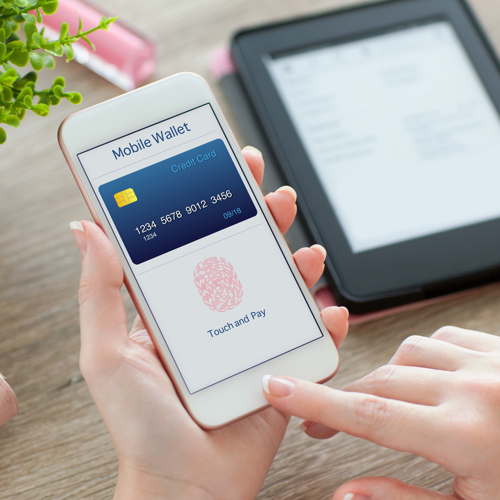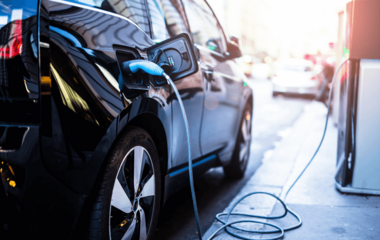
- Five minutes read
What’s next for mobile wallets?
We have already seen huge growth in consumer adoption in the past two years. But have we reached a crossroads, and what does that mean for businesses?
We have already seen huge growth in consumer adoption in the past two years. But have we reached a crossroads, and what does that mean for businesses?
The growth of mobile wallets - a payment method such as Google Pay or Apple Pay, where a customer registers their bank card details to a smartphone which are then tokenized to create a simple and secure payment method stored within the device - has been a defining trend of the payments industry for a number of years. Across the globe, we have seen consumers adopt this alternative to traditional card payments for both online and in-store payments; for example, according to a report mobile wallets usage jumped 29% in the U.S. in 2020, to 40% of all smartphone users over the age of 14. Overall, more than half of U.S. consumers are using some form of contactless payment method, which includes contactless credit and debit cards, demonstrating the deeper appetite for more seamless payment methods.
And there are clear benefits of mobile wallets that make them appealing to consumers:
- Speed – Payments can be made through a single step process that doesn’t require multi-factor authentication
- Convenience – Stored card details means consumers don’t need to remember long card number details, or bring a physical wallet with them when shopping in-store
- Security – Mobile wallets payments are verified using biometrics, which is more secure than memorising passwords. Card details are more strongly protected and unlike traditional debit and credit cards the payment method cannot be used if physically stolen
Why is consumer adoption so high now?
Beyond these benefits, there are a number of factors we can point to to understand why we are seeing this growth:
- Global smartphone adoption Simply having a smartphone and access to the internet is the major global stumbling to mass migration to mobile wallets from debit and credit cards, or (more likely in developing countries) cash. But this has become less of a factor in recent years as smartphone penetration has steadily increased, and this trend is project to continue. Global smartphone users have increased from just 3.67 billion people in 2016 to 6.38 billion people in 2021 (80.6% of the global population, and 89.7% of all mobile phone users), and is predicted to reach 7.33 billion people by 2025.
- The growth of mCommerce – Not only do more consumers around the globe now own a smartphone, they are increasingly using them as a device to access digital commerce. In the U.S. this translates into 79% of consumers using their smartphone to make at least one online purchase in the past six months. Globally, mCommerce now dominates the digital commerce landscape; the percentage of all online transactions that takes place on a mobile device has risen from just over 50% in 2016 to 72.9% in 2021. This figure values the total global mCommerce market at $3.56 trillion this year.
- The impact of COVID-19 And, much like many payment trends we have seen emerge in the past two years, the underlying direction of travel has been accelerated significantly by the COVID-19 pandemic. Most notably for mobile wallets, rapid growth of contactless adoption as consumers and businesses veered away from using cash in the early stages of the pandemic resulted in the growth of mobile wallets and contactless cards. When we asked consumers in May 2021, 74% told us that they were now making regular contactless payments in stores. But this isn’t the only impact of COVID-19; mobile wallet usage grew online during the pandemic as well. In the same research, a third (32%) of consumers told us that they were using digital wallets including Apple Pay and Google Pay more regularly due to the pandemic, and 23% said they used the payment method for the first time since the start of the outbreak.
And the impact of COVID-19 extends beyond the regions we surveyed. For example, mobile wallet adoption in Asia has exploded due to the pandemic. According to research carried out earlier this year, mobile wallet penetration in Thailand is 93.7%, and other countries in the region are not far behind. To put this into perspective, the same research estimates mobile wallet adoption in the UK and U.S. is 36.5% and 42.8% respectively.
The response from businesses
Of course, consumer adoption must be supported by businesses buying into the trend and offering mobile wallets as a payment method in their stores and online checkouts. For businesses, there are clear benefits for meeting consumer demand:
- Improved conversion rate
- Quick checkout
- Expanded payment options
- Higher security
- Consumer data protection
- Global reach
- Lower chargeback rates
And that is what we are seeing. According to our latest research Lost in Transaction: Finding competitive advantage at the checkout, businesses are buying into offering mobile wallets and the growth we have already seen is only going to accelerate in 2022.
We asked 900 small to medium-sized businesses (SMBs) across Europe, North America, and Latin America to tell us about their plans for evolving their online checkouts in the next 12 months, and mobile wallets will play a significant role.
Overall, 41% of online SMBs told us that they already offered mobile wallets in their online checkout, and this growth is being driven by the U.S. (51%), UK (47%), and Germany (47%). And a further 36% of businesses told us that they are planning to integrate mobile wallets into their checkouts within 12 months. Less than a quarter (23%) of all businesses currently have no plans to integrate mobile wallets into their online checkouts. Of those that already accept mobile wallets, over half (54%) have seen an increase in the percentage of their overall checkout transactions being made via a mobile wallet.
The year ahead
More than two thirds (68%) of online SMBs say that COVID-19 has made an impact on the way consumers are paying, and more than half (52%) say they are actively being asked by their customers to offer more payment options. So it is not surprising that 61% are accelerating their plans to improve their checkout experience, and integrating mobile wallets to match consumer demand is going to play a huge role here. SMBs that aren’t thinking about offering mobile wallets already may find themselves becoming uncompetitive in the next 12 months.




